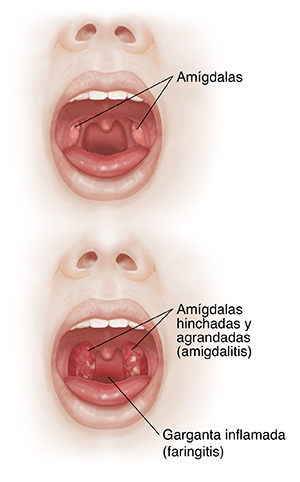When Your Child Has Pharyngitis or Tonsillitis
When Your Child Has Pharyngitis or Tonsillitis

Your child’s throat feels sore. This is likely because of redness and swelling (inflammation) of the throat. Two areas of the throat are most often affected: the pharynx and tonsils. Inflammation of the pharynx (pharyngitis) and inflammation of the tonsils (tonsillitis) are very common in children. This sheet tells you what you can do to relieve your child’s throat pain.
What causes pharyngitis or tonsillitis?
Most commonly, pharyngitis and tonsillitis are caused by a viral or bacterial infection.
What are the symptoms of pharyngitis or tonsillitis?
The main symptom of both conditions is a sore throat. Your child may also have a fever, redness or swelling of the throat, and trouble swallowing. You may feel lumps in the neck.
How is pharyngitis or tonsillitis diagnosed?
The healthcare provider will examine your child’s throat. The healthcare provider might wipe (swab) your child’s throat. This swab will be tested for the bacteria that causes an infection called strep throat. If needed, a blood test can be done to check for a viral infection such as mononucleosis.
How is pharyngitis or tonsillitis treated?
If your child’s sore throat is caused by a bacterial infection, the healthcare provider may prescribe antibiotics. Otherwise, you can treat your child’s sore throat at home. To do this:
-
Give your child acetaminophen or ibuprofen to ease the pain. Don't use ibuprofen in children younger than 6 months of age or in children who are dehydrated or vomiting all of the time. Don’t give your child aspirin to relieve a fever. Using aspirin to treat a fever in children could cause a serious condition called Reye syndrome.
-
Give your child cool liquids to drink.
-
Have your child gargle with warm saltwater if it helps relieve pain. An over-the-counter throat numbing spray may also help.
What are the long-term concerns?
If your child has frequent sore throats, take him or her to see a healthcare provider. Removing the tonsils may help relieve your child’s recurring problems.
When to call your child's healthcare provider
Call your child’s healthcare provider right away if your otherwise healthy child has any of the following:
-
Fever (see Fever and children, below)
-
Sore throat pain that persists for 2 to 3 days
-
Sore throat with fever, headache, stomachache, or rash
-
Trouble turning or straightening the head
-
Problems swallowing or drooling
-
Trouble breathing or needing to lean forward to breathe
-
Problems opening mouth fully
Fever and children
Always use a digital thermometer to check your child’s temperature. Never use a mercury thermometer.
For infants and toddlers, be sure to use a rectal thermometer correctly. A rectal thermometer may accidentally poke a hole in (perforate) the rectum. It may also pass on germs from the stool. Always follow the product maker’s directions for proper use. If you don’t feel comfortable taking a rectal temperature, use another method. When you talk to your child’s healthcare provider, tell him or her which method you used to take your child’s temperature.
Here are guidelines for fever temperature. Ear temperatures aren’t accurate before 6 months of age. Don’t take an oral temperature until your child is at least 4 years old.
Infant under 3 months old:
-
Ask your child’s healthcare provider how you should take the temperature.
-
Rectal or forehead (temporal artery) temperature of 100.4°F (38°C) or higher, or as directed by the provider
-
Armpit temperature of 99°F (37.2°C) or higher, or as directed by the provider
Child age 3 to 36 months:
-
Rectal, forehead (temporal artery), or ear temperature of 102°F (38.9°C) or higher, or as directed by the provider
-
Armpit temperature of 101°F (38.3°C) or higher, or as directed by the provider
Child of any age:
-
Repeated temperature of 104°F (40°C) or higher, or as directed by the provider
-
Fever that lasts more than 24 hours in a child under 2 years old. Or a fever that lasts for 3 days in a child 2 years or older.
Updated:
June 05, 2019
Reviewed By:
Ashutosh Kacker MD